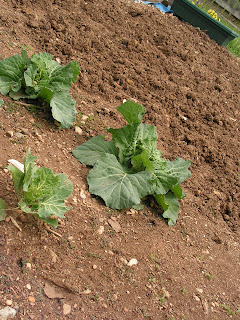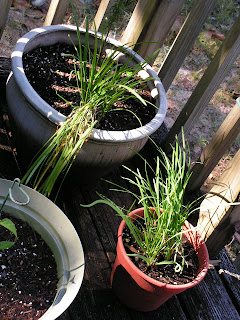But many summer gardeners are surprised to learn how much they can grow if they begin in early spring. The first few years I gardened I, too, was a summer gardener only. I grew tomatoes, squash, peppers, cucumbers, etc. but not much else. Gradually, however, I began to branch out, or should I say branch earlier? I tried backing my season up just a few weeks so I could get a decent crop of lettuce in before heat made it bolt. And then, I decided I wanted to try for some radishes--also an early crop. Exploring the garden center for these plants made me realize many things grow when a light frost is still a possibility, and some when the soil is barely workable after the winter freeze.
Eventually, I went full-blown with the spring garden plot. Today, my garden looks like you see above. Whereas a few years ago, it would have all been like the "back 40" of plain tilled soil, now the front section is already in full spring growth and giving me a small crop of salad-ready fare. So what grows early, or throughout the winter in parts of the country that don't dip below freezing too often?
Spinach and some early types of lettuce. These are ready for harvest now, as are some of the radishes. You can see the succession planting of the radishes below on the right. The outer row was planted a couple of weeks after the inner row, so I should have radishes until the weather turns too warm for them, sometime in later June if I keep planting steadily.
In front of the radishes, the snow peas are growing. Soon they'll be tall enough to need their stakes, and eventually they'll bloom. While they are not even close to harvest-ready yet, they are nevertheless a cool-weather plant that requires some time to produce its crop, so if you want to have peas in the early summer, you need to plant them during the season of light frosts. Although they are in another part of the garden, much the same can be said of the brussels sprouts, although the dill growing up around them is ready to pick as a green right now, especially as it is self-seeded and needs some serious thinning.
Onions planted a week and a half ago are popping up, and their bed could already use a cleaning as the maple seeds have blown into it.
While they haven't shown up yet--in fact, they might not grow at all seeing I used last year's seeds which might have been a mistake--carrots are planted in a large pot. You can see from my soil that the rocky aspect makes in-ground planting of root crops unsuccessful. Onions and garlic do alright, but carrots and potatoes come out rather mis-shapen. They end up living in the container garden zone. And come to think of it, it's potato planting time, in fact, it's almost past it in this climate zone.
On the larger side of above-ground crops, the cabbage is coming along well...
...as is the broccoli. These two larger plant varieties, as well as cauliflower, will be ready for harvesting even while the summer seedlings are just getting a good start. In a couple more weeks, summer plantings of tomatoes, beans, squash, peppers and cucumbers will fill in the bare-tilled area, and as the spring crops finish their cycle, their ground space can be repurposed for the second succession of some of those summer plantings. Of course, if you're using the soil this aggressively you'll need to do plenty of fertilizing and feed those plants faithfully.
The windowsill is empty of life now, scrubbed clean of the rings left by those starter pots that embellished it. The sunflowers that were residing here are officially relocated into the wildflower garden, although they are still very small and very fragile. Everything in the wildflower garden is in its infancy, but soon enough those little "handful" vases will have flowers draping all over them.
Now, while you're busy doing the "big work" of prepping a large portion of your garden for that seasonal change, might I recommend this technique for making a quick and easy egg salad lunch to plop on your bed of fresh spinach? I did try this one before linking it here and can say it worked quite well. What's more, it requires far less supervision than making a pot of boiled eggs, and for me this time of year is NOT the time to prove that a watched pot never boils!
Bonus blog link: http://www.larksongknits.com/2012/04/27/hard-cooked-eggs/
Happy cycling!






































